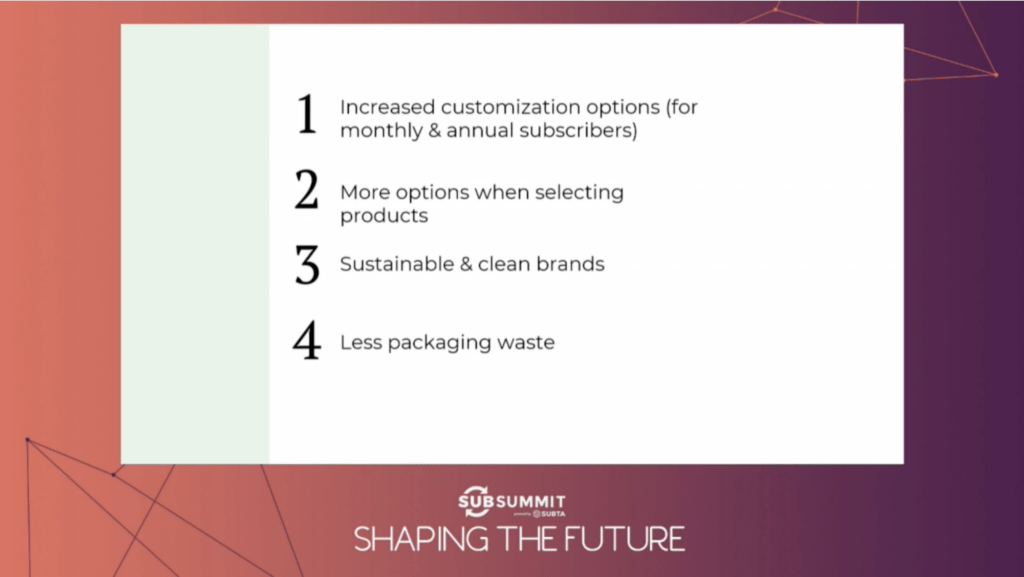Stepping onto the floors of SubSummit 2021, looking out at the 65 vendor booths as the 509 in-person attendees streamed in, I was overjoyed to see smiles on people’s faces and feel the energy in the room build. As the opening ceremonies kicked off, a single thought dominated in my mind: “We all made this happen.”

This year’s SubSummit conference brought together dozens of subscription industry experts to share the insights gleaned from data collected by payment processing platforms, merchant tools, and growth-hacking softwares. And the data shared promises to have a major impact on the future of the subscription business model.
While we in the subscription industry pride ourselves on getting to know our customers and catering to their needs and desires, there are five data-backed trends that may surprise you.
Whether these insights illuminate new ideas for marketing strategies or they inspire you to innovate as you enter the expansion stage of your subscription business, be sure to read these five surprising future trends while sitting down.
Surprise #1: Boomers, Millennials & Gen Zers Want Wildly Different Things Out of a Subscription
During this year’s SubSummit event, Jeremy King, CEO & Founder of Attest, blew the audience away with the data revelations in his talk, “What Consumers Want: Real Consumer Gaps, Needs and Expectations for D2C in 2022.”
While all consumers agree on one thing — that practicality is the absolute most important factor in their perceived value of a subscription — King found vastly different preferences among Gen Z consumers versus Boomers and Millennials.
For most adults, “indulgent subscription boxes are the least popular,” says King. Great, you might be thinking. That’s in alignment with the fact that consumers value practicality.
But then the younger generation comes in and throws us a curveball.

Gen Z consumers — those ages 18-25 — say that “indulgence” is the most important factor in whether or not they like and stay with a subscription box. Whether Gen Zers may be looking at the word “indulgence” differently than Boomers and Millennials or the younger generation is simply craving a bit of extravagance in their lives is yet to be seen.
What you can be sure of, though, is that your demographics matter. If you’re catering to a younger generation, adding “indulgence” as a value proposition is a smart move. Conversely, if your target market is comprised of Boomers and Millennials, focus on practical, inspirational products or content, and items or experiences that encourage people to try something new.
Lastly, if you’re catering to both, make sure your subscription has multiple offerings so that all of your subscribers can feel valued and heard. Remember, personalization and customization go a long way in creating a healthy subscription business model.
Surprise #2: People Want More Customization & Your Subscription Business Model Better Accommodate
This year’s sessions had a tremendous amount of data, insights, and shocking revelations. One of the event’s most attended talks featured Simran Dua, CEO of My Subscription Addiction (MSA), one of the largest subscription review sites with more than 3 million visits per month and a strong community of customers.
Dua gave her value-packed keynote on “2021 Trends and Insights from the MSA Team and the Subscription Insiders.”
The MSA team found that there are two main themes for what makes people happy with their subscriptions today. The first is that annual subscribers, in particular, want increased customization and more options when selecting products.

Customers are entering into a long-term relationship with you, said Dua, and they need to feel like you know them and are tailoring the experience to them.
Furthermore, consumers care about sustainability and less waste. However, this needs to be experienced and proven in the products and materials you’re shipping to your subscribers. Consumers don’t like to receive boxes within boxes in their subscriptions, particularly food subscriptions.
Overall, consumers are screaming, “Know me!” and are actively seeking subscriptions that allow them to feel seen and heard. Keep asking yourself questions like:
- “Do I know my audience?”
- “Are my subscribers satisfied with my product or are they happy?”
- “Am I doing everything I can to deliver a great experience alongside my product?”
When you focus on building connections, you’ll inevitably build resilience and a healthy LTV into your subscription.
Surprise #3: Clothing, Shoes, Cannabis & Alcohol Are in the Highest Demand
In his talk, “What Consumers Want: Real Consumer Gaps, Needs and Expectations for D2C in 2022,” Jeremy King of Attest also revealed the specific products that are most likely to grow in the future.
The Millennial and Gen Z consumer population is increasing. And according to research from Attest, the most in-demand products are clothing and shoe subscriptions.
While Millennials and Gen Zers admit that they have plenty of options to choose from when it comes to selecting a clothing or shoe subscription (though they’d still like to see more), there are specific gaps where no companies are truly fulfilling consumer demands.
According to King, these gaps are constantly forming and reforming. However, based on recent research King conducted specifically for his talk at SubSummit 2021, the two markets that consumers are begging for more options in are alcohol and cannabis.
If you’re considering launching a new subscription business or adding a new product vertical to your existing subscription business model, consider whether clothing, shoes, alcohol, or cannabis products are a viable strategy.
Surprise #4: Purpose Is Cool, But Value Still Wins

One of the overarching themes that we heard among many of our expert speakers at SubSummit 2021 is that while consumers do value companies that have a purpose or a mission, it’s not what’s most important to them.
In his data-packed presentation, Jeremy King of Attest hammered this message home for us when he said, “value for money is by far the most important thing.” In fact, according to King’s data, only 1 in 4 consumers are driven by the brand having a strong purpose or ethos, and these people are most commonly Gen Zers.
When designing your subscription business model, it’s not enough to have a giveback. “Purpose alone will not help you win in subscription in 2022,” King said.
A mission-driven purpose can breed community and loyalty, but what people really want – and something that’s non-negotiable – is value inside the box.
Surprise #5: Customers of Entertainment Services Don’t Hate Ads As Much As We Thought
Thirty years ago, one of the best ways to get your brand in front of customers was television advertising. Since the invention of the internet, though, we’ve put a far greater sense of value and priority on digital marketing such as Google ads, social media, and SEO.
However, according to Jon Giegengack’s talk, “Triple Win: The opportunity for Ad-Supported Content in an on-Demand World,” ad-supported content such as streaming services may be a viable marketing strategy for your subscription business model.
In fact, when asked for the main reasons why consumers sign up with entertainment services, “avoiding ads” was not among the top reasons. “Not even close,” says Giegengack, Principal at Hub Entertainment Research.

Rather, most people sign up in order to access exclusive content (51% of respondents), because they see the service as offering good value for the cost (46% of respondents), and because the service has a deep catalog of options to choose from (46% of respondents).
Furthermore, Giegengack and his team found that consumers would rather watch free content even if ads were included than have to pay to watch.
So what does this all mean for your subscription business? Consumers are not as averse to ads as we may have thought. When considering marketing strategies for your subscription business, ad-supported entertainment platforms may be a viable option for reaching new audiences.
Your subscription business model hinges on the demand of your consumers. The data revealed during SubSummit 2021 shows that what subscription companies think consumers want is not fully aligned with what consumers say that they want when polled.
As you head into 2022 and you begin to design your future subscription business model, consider these consumer trends and leverage the opportunities listed above.
While SubSummit 2021 was jam-packed with surprising insights into how to build a subscription business model that will last the test of time, what was most surprising of all was seeing how comfortable we as a community were together. From exchanging business cards to swapping tips that only subscription owners would fully appreciate, the camaraderie was palpable. I attribute the great success of SubSummit 2021 to the incredible community we’ve been able to build and maintain over the past 18 months of digital-everything.
Now that we’re establishing a new hybrid event standard in the covid-world, I and my team at SUBTA are eager to create even more opportunities for us all to break bread together, make memories together, and grow together.


